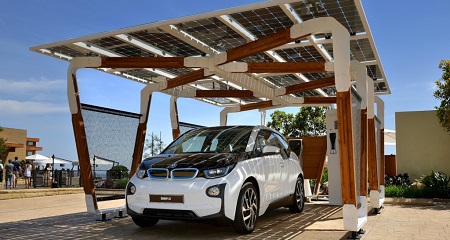The Washington Post raved about the benefits of solar carports earlier this year. It said aesthetics, environmental benefits and ability to use a paved area – rather than green land – to create energy are reasons why the carport market is increasing in size, despite added costs.
The annual installed capacity of carports tripled from just shy of 50 MW in 2010 to 157 MW in 2013, according to GTM Research, and is expected to hit 318 MW in 2016.
 BMW i Solar Carport Concept. Image Credit: BMWGroup
BMW i Solar Carport Concept. Image Credit: BMWGroup
The growth is in line with the rest of the solar industry. And while solar canopies and carports are more expensive – the increased material, engineering and labor adding to the bottom line – they possess a distinct advantage over rooftop systems that drives their success: people can see them.
“Solar carports scream, ‘We’re green!’” said Mike Stevens, a sales executive with Ohio-based Dovetail Solar and Wind. The company is finishing a 335-kW solar canopy on a car dealership along a main road in Cleveland. More than 100 cars will fit under the canopy, protected from summer sun and winter snow, letting people can shop comfortably under an alluring and brightly lit green-energy canopy.
“Public perception aids tremendously to the sale of solar carports,” said John Sarantakes, executive vice president of business development at Texas-based Meridian Solar. “Positive public perception is a draw proving demand is there, justifying the investment.”
The carport market resides largely in the commercial, government and educational spaces. School parking lots outfitted with solar carports proved to be a boon for the business in 2012, providing nearly half of the projects, and in 2013, contributing 39%, according to GTM. California has been the main state for carport installations, followed by New Jersey and Arizona.
As for how contractors could best take part in the market, coordinating with construction companies early on in the process is one way.
“There are considerable cost savings when carport foundations and electrical raceways are installed during the process of constructing new buildings,” said Bennett Ford, senior engineer at Meridian Solar. “As developers and architects become familiar with PV energy systems, they are increasingly engaging with PV design professionals early enough in the development process to incur those savings.”
Published with permission from the original publication on Solar Power World Online By Steven Bushong.










Comments